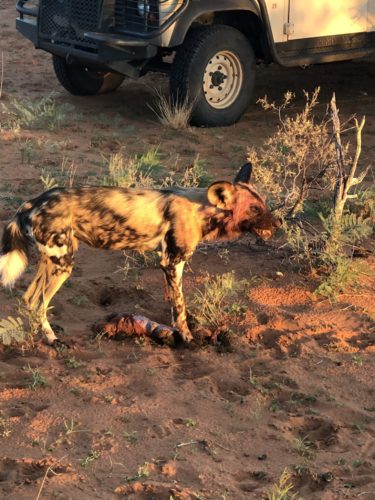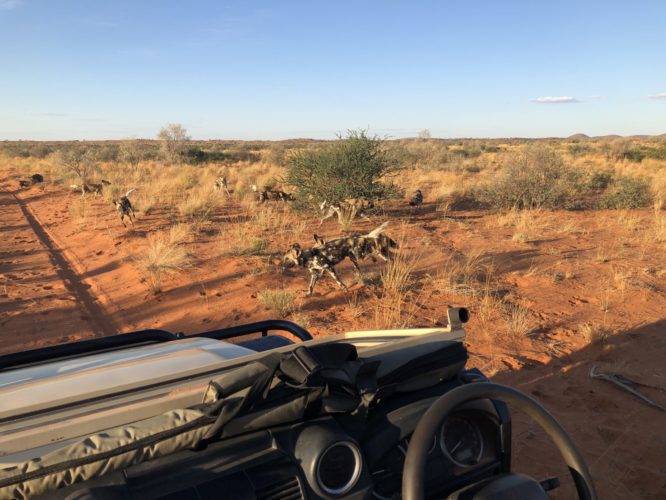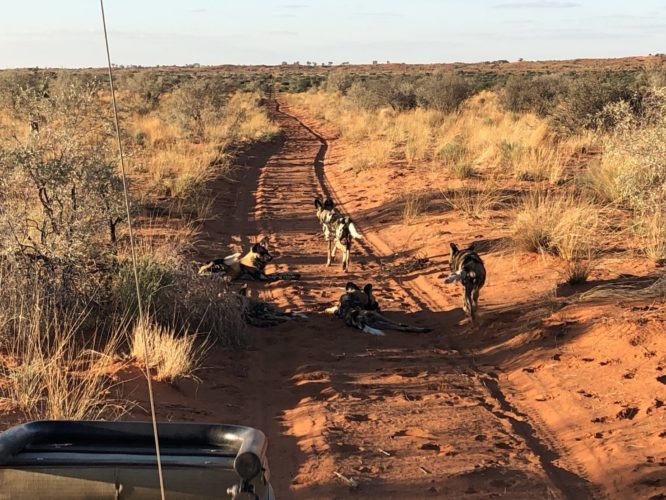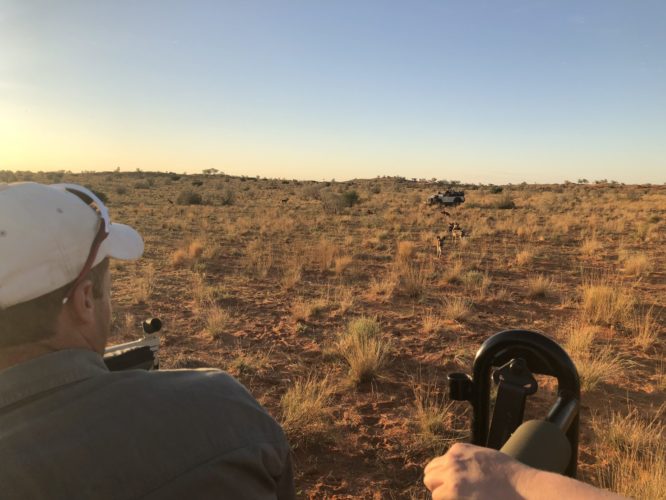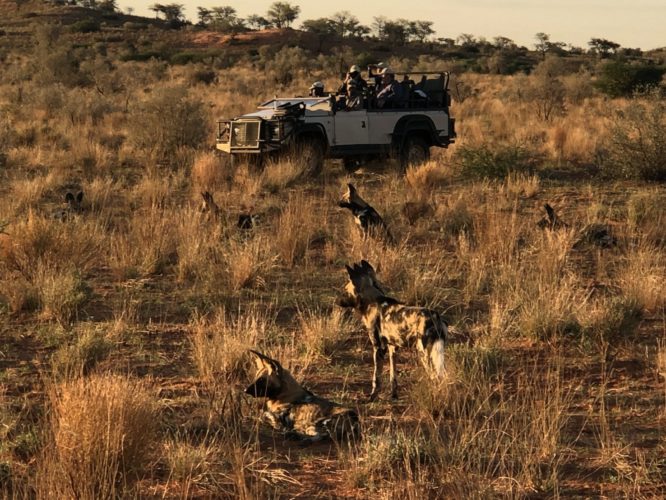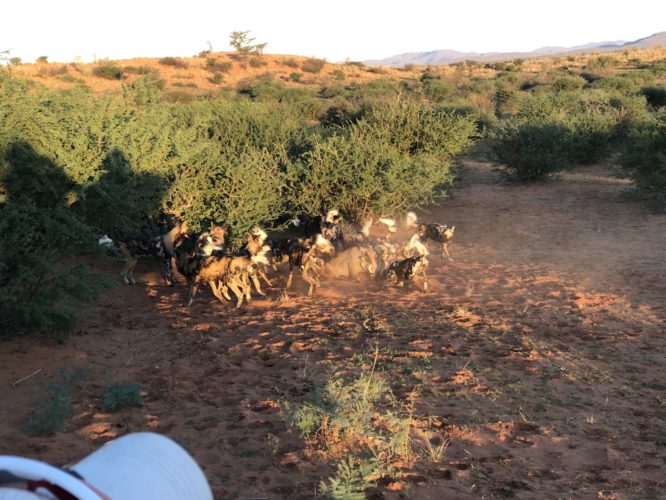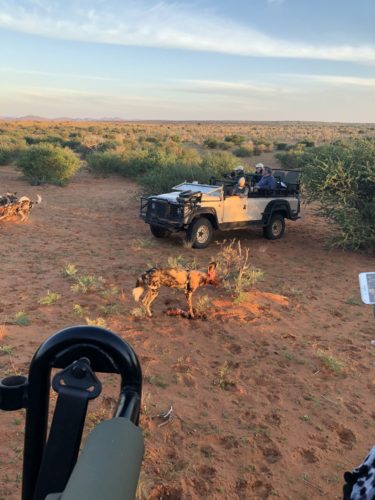“Let’s go see some dogs.”
With that sentence, we were off on one of the rarest, most devastating and utterly thrilling adventures you can have while on safari in Africa.
The canines in question were African wild dogs, also known as painted dogs thanks to their beautiful markings. Now, while in real life I am a crazy dog person, in Africa I’m all about the (big) cats.
“Breathless tales from guides, trackers and fellow travellers explaining how
wild dogs are legendary predators left me desperate to witness them in action”
I assumed African wild dogs would be scavengers along the lines of hyenas, and wasn’t particularly fussed about seeing them – initially, at least. After a while, however, breathless tales from guides, trackers and fellow travellers explaining how wild dogs are, in fact, legendary predators left me desperate to witness them in action.
We were in Tswalu, located in the Kalahari Desert in the Northern Cape province. Tswalu is South Africa’s largest private game reserve and, covering an area of more than 100,000 hectares, absolutely massive. So how on Earth where we going to find a pack of 16 wild dogs in this huge expanse of majestic wilderness?
As it turned out, a couple of the animals are collared with a tracking device, which emits rough details of their whereabouts every few hours. They’re a helpful tool but not an exact science, and it still requires some seriously excellent tracking skills to actually find the dogs. Fortunately, Tswalu has just the people for the job: guides Juan and Callie, and trackers David and Jacob. In two safari vehicles, they systematically and methodically combed the large area in which the dogs were predicted to be.
Driving with Juan and David, our radio would crackle to life every so often with updates from the others. They were in Afrikaans, so we had no idea if the news was positive. That is, until Juan turned to us after one such call and uttered the magical sentence that made the hairs on the backs of our necks stand up: “Let’s go see some dogs”.
“The sun was getting very low in the sky as we tore across the arid savannah towards the pack, and we were going to need a good dose of luck to find the dogs”
With all of us whooping and hollering like possessed banshees, Juan floored the accelerator and raced towards the spot where the dogs were supposedly gathered. It was quite a distance away, and the fear was that we wouldn’t get there in time to see them in action. African wild dogs, you see, tend to hunt most days, usually at sunrise or sunset. The sun was getting very low in the sky as we tore across the arid savannah towards the pack, and we were going to need a good dose of luck to not only find the dogs, but also to see them hunt that evening – perhaps they had already eaten at sunrise.
We were in luck.
We summited a small hill to discover the dogs chilling out and enjoying the last rays of the day, their bellies noticeably crying out for a good feed. Pulling up alongside the animals we listened as Juan explained that every pack has an incredibly structured social order and complex hierarchy, led by an alpha male and an alpha female. When the time came for the African wild dogs to hunt, he explained, they would give the signal and the dogs would engage in all manner of sniffs, licks and tail-wags, make a range of strange chattering and twittering sounds, and generally just psych themselves up for the hunt.
“We thought we were in for an epic battle when the dogs got an oryx in their sights”
It all played out exactly as Juan predicted, and pretty soon the pack had completed their ritual and set out at a leisurely trot, looking for suitable prey. Generally speaking this is a smaller animal, but they have been known to take down large beasts like kudu, wildebeest or even zebra. We thought we were in for an epic battle when the dogs got an oryx in their sights and made a half-hearted attempt at chasing it, but the oryx called their bluff and stood its ground, charging to show his dominance. So the dogs gave up. The oryx lived another day.
The pack continued on its mission, fanning out in a hugely ordered style in order to locate their evening meal. It’s fascinating to watch when they get something in sight: they’re completely silent and communicate via body language, such as the position of their ears – when they’re completely flattened back you know you’re in for some action.
And so it was on this memorable evening. After a number of false starts, tearing across the bumpy plains as we endeavoured to keep up with the swift pack, they finally got sight of a warthog that apparently had “eat me” written across it in bold letters. Juan turned back, gave us the nod and we were off! Hanging on for dear life we raced after the dogs, which split up during the hunt in order to drive their quarry towards their fellow pack mates.
“The chase was so thrilling that I hadn’t really thought about what came next. Be warned, it’s brutal”
It’s a deadly effective move which, when combined with their speed and incredible endurance (these animals can run at a good pace for miles and miles – and super-fast in short bursts) explains why wild dogs have such a good strike rate. About 80% of their hunts end successfully, while lions, as a comparison, can only manage around 10%.
The chase was so thrilling that I hadn’t really thought about what came next. Be warned, it’s brutal. The wild dogs brought down the warthog and immediately began feeding, even before it had died. Our guides informed us that the warthog would be so amped up on adrenalin that it would feel little pain, but it was difficult to reconcile this thought with the agonising sounds of the warthog, punctuated by the strange, high-pitched chattering and squeaks emitted by the wild dogs as they fed. It’s a difficult thing to experience, especially for the first time, but the “Circle of Life” lyrics kept running through my head, and I reminded myself that while warthogs are ten-a-penny in the African bush, the African wild dog is an endangered species.
We stayed until the bitter end, fascinated by the behaviour of the dogs who are driven by the knowledge that their survival depends entirely on their incredible teamwork. It extends even to the way they eat, letting the younger ones go first, being sure to take food back to any nursing mothers and cubs (via the revolting, but effective, method of regurgitation) and generally just ensuring everyone gets their fill – if not, they hunt again.
Witnessing the pack working together to ensure the survival of all is an extraordinary experience – illuminating, humbling, shocking and, above all, hugely exciting. If you have the chance to witness a hunt when you’re on safari, don’t miss it.
Now the video we’ve created is raw footage from our i-phones so not professional quality, but enough to get a sense of the anticipation and brutality of the kill.
